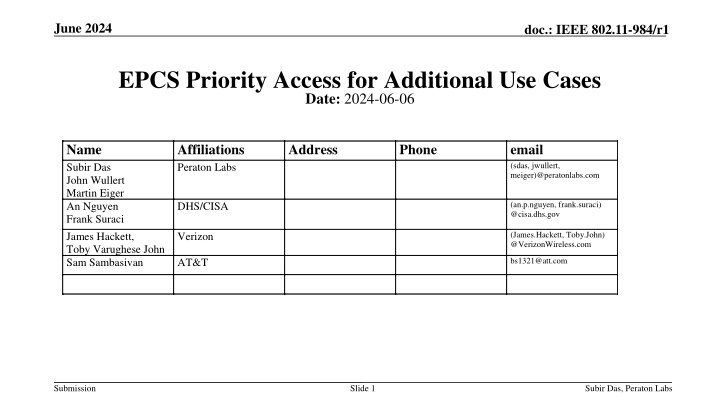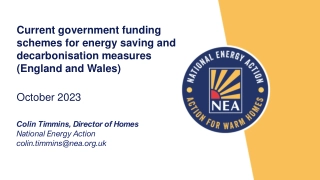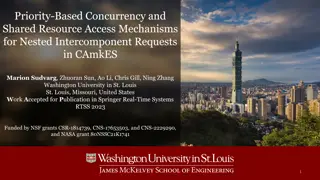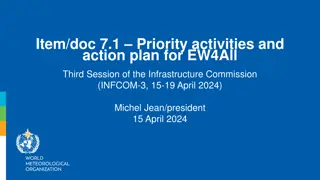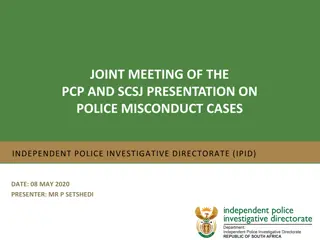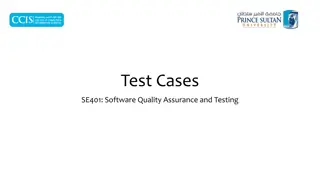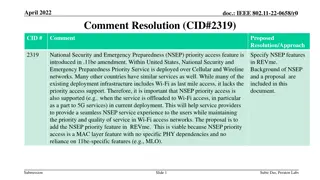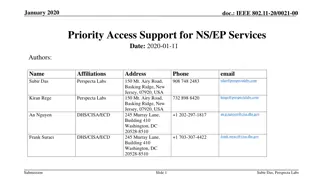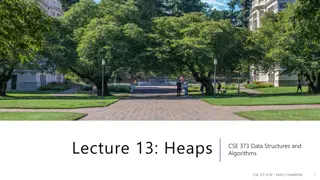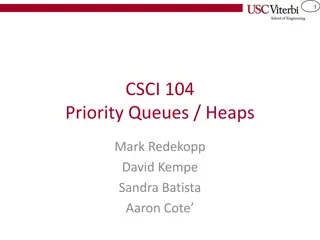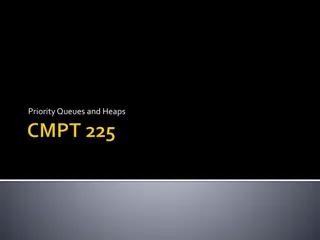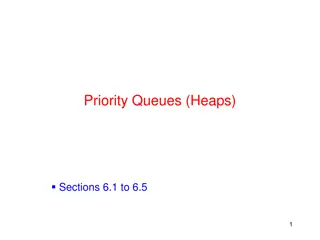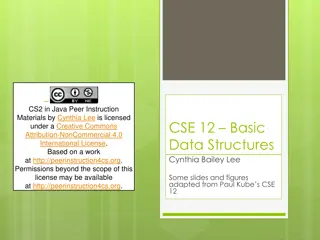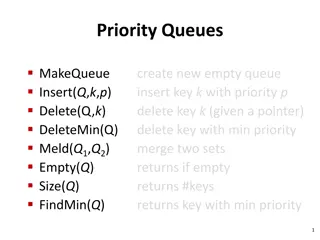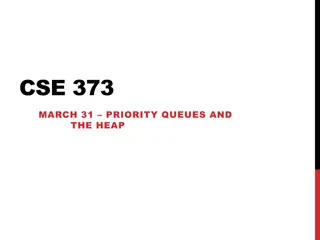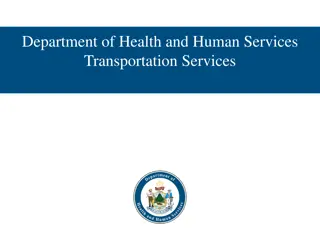EPCS Priority Access for Additional Use Cases
This presentation delves into EPCS Priority Access in IEEE 802.11 for emergency preparedness communications during critical situations. It discusses the need for prioritizing access to support essential use cases and addresses regulatory updates concerning Wireless Priority Service in the USA.
Download Presentation

Please find below an Image/Link to download the presentation.
The content on the website is provided AS IS for your information and personal use only. It may not be sold, licensed, or shared on other websites without obtaining consent from the author.If you encounter any issues during the download, it is possible that the publisher has removed the file from their server.
You are allowed to download the files provided on this website for personal or commercial use, subject to the condition that they are used lawfully. All files are the property of their respective owners.
The content on the website is provided AS IS for your information and personal use only. It may not be sold, licensed, or shared on other websites without obtaining consent from the author.
E N D
Presentation Transcript
June 2024 doc.: IEEE 802.11-984/r1 EPCS Priority Access for Additional Use Cases Date: 2024-06-06 Name Subir Das John Wullert Martin Eiger An Nguyen Frank Suraci James Hackett, Toby Varughese John Sam Sambasivan Affiliations Peraton Labs Address Phone email (sdas, jwullert, meiger)@peratonlabs.com (an.p.nguyen, frank.suraci) @cisa.dhs.gov DHS/CISA (James.Hackett, Toby.John) @VerizonWireless.com Verizon bs1321@att.com AT&T Submission Slide 1 Subir Das, Peraton Labs
June 2024 doc.: IEEE 802.11-984/r1 Abstract This presentation discusses the need for EPCS Priority Access to support additional use cases Submission Slide 2 Subir Das, Peraton Labs
June 2024 doc.: IEEE 802.11-984/r1 Background EPCS (Emergency Preparedness Communications Service) Priority Access features were specified in IEEE 802.11be for supporting National Security and Emergency Preparedness (NSEP) Communications The use case required Non-AP MLD to be successfully authenticated and associated with an AP MLD before EPCS Priority Access can be enabled AP MLD can grant the EPCS Priority Access once it verifies that non-AP MLD has the authority to use the features Either non-AP MLD or AP MLD can request and teardown the EPCS Priority Access This feature is optional in IEEE 802.11be Submission Slide 3 Subir Das, Peraton Labs
June 2024 doc.: IEEE 802.11-984/r1 Use Case and Requirement Use Case I: During emergencies, network congestion may present users with emergency preparedness responsibilities from (re)associating. Enabling their access requires that STAs capable of obtaining EPCS Priority Access (i.e., those configured to be authorized for the service) should be able to transmit management frames for authentication and association with higher priority than normal STAs Failure to support the above will prevent EP personnel, whose mission is to help the citizens during emergencies and save lives, from performing their responsibilities The current solution in IEEE 802.11be does not support the above use case The scope in IEEE 802.11be was limited and it was appropriate at that time Given the market acceptance of the EPCS features, it is essential that we address this use case in IEEE 802.11bn Submission Slide 4 Subir Das, Peraton Labs
June 2024 doc.: IEEE 802.11-984/r1 Regulatory Update in USA Federal Communication Commission (FCC) within United States released a new Report and Order (FCC-22-36) addressing the Wireless Priority Service (WPS) (a.k.a., NSEP Priority Service) in 2022 Report and Order (R&O) specifies operation of priority service on public wireless communications networks A Few highlights on Wireless Priority Service (WPS) Explicitly authorizes WPS preemption of public communications Expressly permits priority voice, video, and data sessions Expressly authorizes priority signaling (registration, invocation) Expands WPS eligibility to include additional users Clarifies that higher priority users take precedence over those with lower priority Five (5) priority levels were defined in earlier R & O Note: Wireless Priority Service (WPS) is not mandated by the FCC Submission Slide 5 Subir Das, Peraton Labs
June 2024 doc.: IEEE 802.11-984/r1 Example Priority Services Offered in Various Countries In Belgium, Blue Light Mobile service enables priority communications for users with national security and emergency preparedness responsibilities Priority involves both exemption network management controls for both lower-and higher-priority users and preemption of other traffic on behalf of higher-priority users In Czech Republic, mobile crises communications service provides priority for three user classes and four priority levels Traffic assigned to priority levels based on user class and situation (e.g., crisis or non-crisis) Service includes variety of priority actions, e.g., calls at highest priority level can preempt lower- priority and non-priority calls other than emergency (i.e., 112) calls. In Denmark, priority communications program provides preferential network access for first responders and individuals supporting critical infrastructure Supports two priority levels, one that includes preferential access by authorized users and another that, when declared, restricts network access by (i.e., preempts) non-priority users Submission Slide 6 Subir Das, Peraton Labs
June 2024 doc.: IEEE 802.11-984/r1 Use case II and Requirements Use Case II: During crisis situation, WLAN may become congested with traffic from general public and users authorized for priority at several levels. To ensure authorized EPCS users can communicate to fulfill their emergency responsibilities, network may need to restrict access. Such restrictions could apply to public users and to EPCS users at lower priority levels on behalf of those at higher priority levels. IEEE 802.11 networks should provide means to enable preemption on behalf of EPCS STAs Preemption could provide critical advantage for NS/EP personnel under extreme conditions Current EPCS priority in IEEE 802.11be only provides probabilistic advantage via EDCA IEEE 802.11 networks should provide means to enable multiple priority levels of EPCS STAs Lack of differentiation among priority users could result in poor performance when many priority users share a BSS (e.g., disaster management site, evacuation shelter) Distinguishing different classes of priority users (e.g., 1-5 according to FCC) and/or service types will help NSEP users to fulfill their roles Given the new regulatory and existing service requirements, it is important that we address the above in IEEE 802.11bn Submission Slide 7 Subir Das, Peraton Labs
June 2024 doc.: IEEE 802.11-984/r1 Straw Poll -1 SP1: Do you agree to define mechanism(s) that enable APs to assign priority channel access to EPCS capable STAs during association? Y N - A - Submission Slide 8 Subir Das, Peraton Labs
June 2024 doc.: IEEE 802.11-984/r1 Straw Poll -2 SP2: Do you agree to define mechanism(s) that enable APs to preempt STAs to better support EPCS authorized STAs? Note: Preempted STAs could include non-EPCS and lower priority EPCS STAs Y N - A - Submission Slide 9 Subir Das, Peraton Labs
June 2022 doc.: IEEE 802.11-984/r1 References IEEE 802.11be Draft 5.1: https://www.ieee802.org/11/private/Draft_Standards/11be/Draft%20P802.11be_D5.1.pdf FCC Review of Rules and Requirements For Priority Services, FCC-22-36, https://www.fcc.gov/document/fcc- modernizes-and-improves-its-priority-services-rules-0 https://mentor.ieee.org/802.11/dcn/22/11-22-1074-01-0wng-priority-access-fcc-r-o-and-additional-use-cases.pdf Information on the Belgium Blue Light Mobile service was found in the following sources (Last viewed May 2024): https://www.astrid.be/en/services/blue-light-mobile, (in English), https://www.astrid.be/sites/public/files/2024-02/BLM_userguide_jan2024_NL.pdf (in Dutch), https://www.criticalcomms.com/content/news/belgium-astrid-launches-the-next-generation-of-its-blue-light- mobile-service (in English), https://www.criticalcomms.com/content/news/belgium-astrid-launches-the-next- generation-of-its-blue-light-mobile-service (in English) Information on the mobile crisis communications services within the Czech Republic was found in the following sources (Last viewed: May 2024): http://www.hzscr.cz/soubor/04-krizova-komunikace-rezim-kompatibility- pdf.aspx (in Czech) and 18 - Communication of the Integrated Rescue System (netstranky.cz) (in Czech). Information on the mobile crisis communications services within Denmark was found in the following sources (Last viewed: May 2024): Beskrivelse af mobilprioriteringsordningen__CFCS_juli 2019 (in Danish) and vejledning-til-prioriteringsordningen-i-4g-netvark.pdf (cfcs.dk) (in Danish) Submission Slide 10 Subir Das, Peraton Labs
